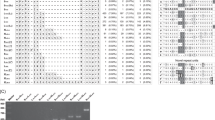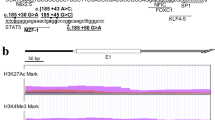Abstract
THE dopamine D4 receptor structurally and pharmacologically resembles the dopamine D2 and D3 receptors1–5. Clozapine, an atypical antipsychotic that is relatively free of the adverse effects of drug-induced parkinsonism and tardive dyskinesia6,7, binds to the D4 receptor with an affinity 10 times higher than to the D2 and D3 receptors1. This may explain clozapine's atypical properties. Here we report the existence of at least three polymorphic variations in the coding sequence of the human D4 receptor. A 48-base-pair sequence in the putative third cytoplasmic loop of this receptor exists either as a direct-repeat sequence (D4.2), as a fourfold repeat (D4.4) or as a sevenfold repeat (D4.7). Two more variant alleles were detected in humans. Expression of the complementary DNA for the three cloned receptor variants showed different properties for the long form (D4.7) and the shorter forms (D4.2, D4.4) with respect to clozapine and spiperone binding. To our knowledge, this is the first report of a receptor in the catecholamine receptor family that displays polymorphic variation in the human population. Such variation among humans may underlie individual differences in susceptibility to neuropsychiatric disease and in responsiveness to antipsychotic medication.
This is a preview of subscription content, access via your institution
Access options
Subscribe to this journal
Receive 51 print issues and online access
$199.00 per year
only $3.90 per issue
Buy this article
- Purchase on Springer Link
- Instant access to full article PDF
Prices may be subject to local taxes which are calculated during checkout
Similar content being viewed by others
References
Van Tol, H. H. M. et al. Nature 350, 610–614 (1991).
Bunzow, J. R. et al. Nature 336, 783–787 (1988).
Grandy, D. K. et al. Proc. natn. Acad. Sci. U.S.A. 86, 9762–9766 (1989).
Dal Toso, R. et al. EMBO J. 8, 4025–4034 (1989).
Sokoloff, P., Giros, B., Martres, M.-P., Bouthenet, M.-L. & Schwartz, J.-C. Nature 347, 146–151 (1990).
Kane, J. et al. Arch. gen. Psychiat. 45, 789–796 (1988).
Casey, D. E. Psychopharmacology 99, 47–53 (1989).
Mount, S. M. Nucleic Acids Res. 10, 461–472 (1982).
Jackson, I. J. Nucleic Acids Res. 19, 3795–3798 (1991).
Bonner, T. I., Young, A., Brann, M. R. & Buckley, N. J. Neuron 1, 403–410 (1988).
La Spada, A. R., Wilson, E. M., Lubahn, D. B., Harding, A. E. & Fischbeck, K. H. Nature 352, 77–79 (1991).
Oberle, I. et al. Science 252, 1097–1102 (1991).
Brook, J. D. et al. Cell 68, 799–808 (1992).
Gelernter, J., Kennedy, J. L., Van Tol, H. H. M., Civelli, O. & Kidd, K. K. Genomics 13, 208–210 (1992).
Kelsoe, J. R. et al. Nature 342, 238–242 (1989).
Keating, M. et al. Science 252, 704–706 (1991).
Chomczynski, P. & Sacchi, N. Analyt. Biochem. 162, 156–159 (1987).
Sambrook, J., Fritsch, E. F. & Maniatis, T. Molecular Cloning (Cold Spring Harbor Laboratory Press, New York, 1989).
Gubier, U. & Hoffman, B. J. Gene 25, 263–269 (1983).
Budowle, B. & Baechtel, F. S. Appl. theoret. Electrophoresis (in the press).
McMaster, G. K. & Carmichael, G. G. Proc. natn. Acad. Sci. U.S.A. 74, 4835–4838 (1977).
Author information
Authors and Affiliations
Rights and permissions
About this article
Cite this article
Tol, H., Wu, C., Guan, HC. et al. Multiple dopamine D4 receptor variants in the human population. Nature 358, 149–152 (1992). https://doi.org/10.1038/358149a0
Received:
Accepted:
Issue Date:
DOI: https://doi.org/10.1038/358149a0
This article is cited by
-
The effect of the 7R allele at the DRD4 locus on risk tolerance is independent of background risk in Senegalese fishermen
Scientific Reports (2023)
-
Art-Rent Concept and Measure With Connections to an Evolving Economy
Journal of the Knowledge Economy (2023)
-
Art Value Creation and Destruction
Integrative Psychological and Behavioral Science (2023)
-
Insights into the Involvement and Therapeutic Target Potential of the Dopamine System in the Posttraumatic Stress Disorder
Molecular Neurobiology (2023)
-
The role of altruistic behavior and genetic influence of DRD4 in resource gain and resource loss spirals
Asia Pacific Journal of Management (2023)
Comments
By submitting a comment you agree to abide by our Terms and Community Guidelines. If you find something abusive or that does not comply with our terms or guidelines please flag it as inappropriate.



